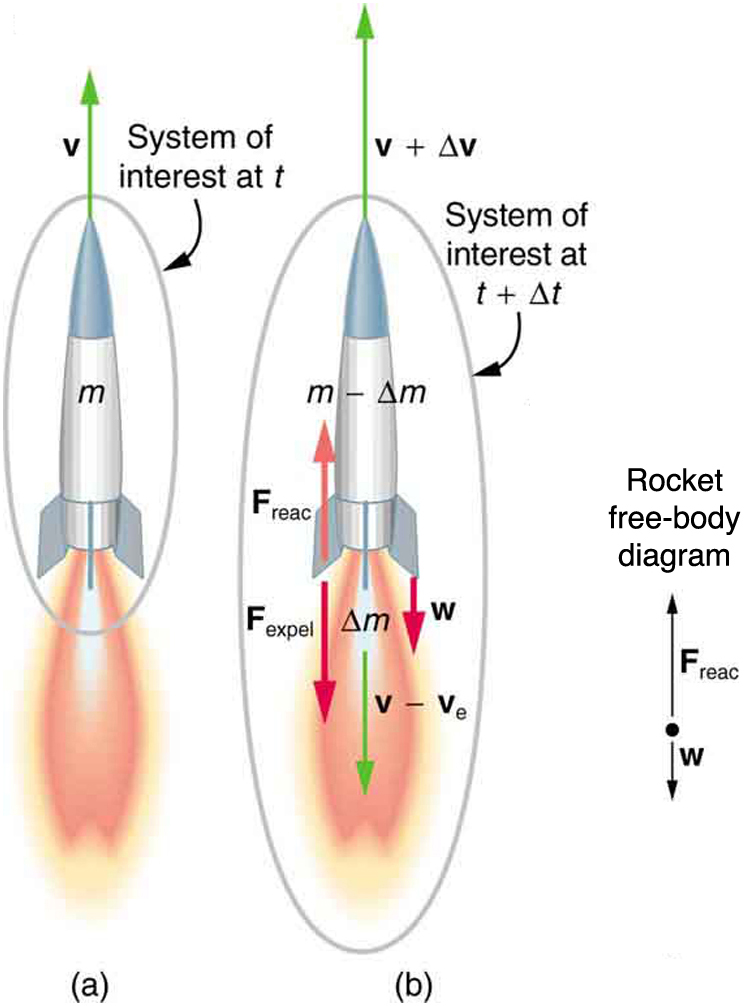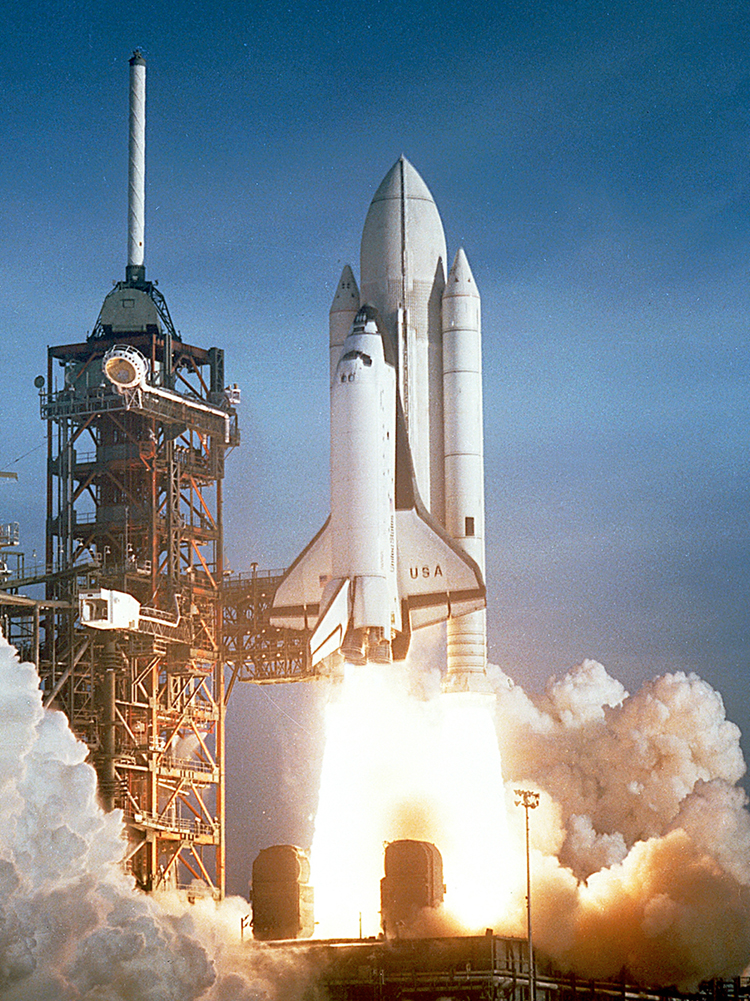Chapter 8 Linear Momentum and Collisions
58 8.7 Introduction to Rocket Propulsion
Summary
- State Newton’s third law of motion.
- Explain the principle involved in propulsion of rockets and jet engines.
- Derive an expression for the acceleration of the rocket and discuss the factors that affect the acceleration.
- Describe the function of a space shuttle.
Rockets range in size from fireworks so small that ordinary people use them to immense Saturn Vs that once propelled massive payloads toward the Moon. The propulsion of all rockets, jet engines, deflating balloons, and even squids and octopuses is explained by the same physical principle—Newton’s third law of motion. Matter is forcefully ejected from a system, producing an equal and opposite reaction on what remains. Another common example is the recoil of a gun. The gun exerts a force on a bullet to accelerate it and consequently experiences an equal and opposite force, causing the gun’s recoil or kick.
MAKING CONNECTIONS: TAKE-HOME EXPERIMENT—PROPULSION OF A BALLOON
Hold a balloon and fill it with air. Then, let the balloon go. In which direction does the air come out of the balloon and in which direction does the balloon get propelled? If you fill the balloon with water and then let the balloon go, does the balloon’s direction change? Explain your answer.
Figure 1 shows a rocket accelerating straight up. In part (a), the rocket has a mass
By calculating the change in momentum for the entire system over
“The rocket” is that part of the system remaining after the gas is ejected, and
ACCELERATION OF A ROCKET
Acceleration of a rocket is
where

A rocket’s acceleration depends on three major factors, consistent with the equation for acceleration of a rocket. First, the greater the exhaust velocity of the gases relative to the rocket,
FACTORS AFFECTING A ROCKETS ACCELERATION
- The greater the exhaust velocity
- The faster the rocket burns its fuel, the greater its acceleration.
- The smaller the rocket’s mass (all other factors being the same), the greater the acceleration.
Example 1: Calculating Acceleration: Initial Acceleration of a Moon Launch
A Saturn V’s mass at liftoff was
Strategy
This problem is a straightforward application of the expression for acceleration because
Solution
Substituting the given values into the equation for acceleration yields
Discussion
This value is fairly small, even for an initial acceleration. The acceleration does increase steadily as the rocket burns fuel, because
To achieve the high speeds needed to hop continents, obtain orbit, or escape Earth’s gravity altogether, the mass of the rocket other than fuel must be as small as possible. It can be shown that, in the absence of air resistance and neglecting gravity, the final velocity of a one-stage rocket initially at rest is
where
Solving for
Thus, the mass of the rocket is
This result means that only
The space shuttle was an attempt at an economical vehicle with some reusable parts, such as the solid fuel boosters and the craft itself. (See Figure 2) The shuttle’s need to be operated by humans, however, made it at least as costly for launching satellites as expendable, unmanned rockets. Ideally, the shuttle would only have been used when human activities were required for the success of a mission, such as the repair of the Hubble space telescope. Rockets with satellites can also be launched from airplanes. Using airplanes has the double advantage that the initial velocity is significantly above zero and a rocket can avoid most of the atmosphere’s resistance.

PHET EXPLORATIONS: LUNAR LANDER
Can you avoid the boulder field and land safely, just before your fuel runs out, as Neil Armstrong did in 1969? Our version of this classic video game accurately simulates the real motion of the lunar lander with the correct mass, thrust, fuel consumption rate, and lunar gravity. The real lunar lander is very hard to control.

Section Summary
- Newton’s third law of motion states that to every action, there is an equal and opposite reaction.
- Acceleration of a rocket is
- A rocket’s acceleration depends on three main factors. They are
- The greater the exhaust velocity of the gases, the greater the acceleration.
- The faster the rocket burns its fuel, the greater its acceleration.
- The smaller the rocket’s mass, the greater the acceleration.
Conceptual Questions
1: Professional Application
Suppose a fireworks shell explodes, breaking into three large pieces for which air resistance is negligible. How is the motion of the center of mass affected by the explosion? How would it be affected if the pieces experienced significantly more air resistance than the intact shell?
2: Professional Application
During a visit to the International Space Station, an astronaut was positioned motionless in the center of the station, out of reach of any solid object on which he could exert a force. Suggest a method by which he could move himself away from this position, and explain the physics involved.
3: Professional Application
It is possible for the velocity of a rocket to be greater than the exhaust velocity of the gases it ejects. When that is the case, the gas velocity and gas momentum are in the same direction as that of the rocket. How is the rocket still able to obtain thrust by ejecting the gases?
Problems & Exercises
1: Professional Application
Antiballistic missiles (ABMs) are designed to have very large accelerations so that they may intercept fast-moving incoming missiles in the short time available. What is the takeoff acceleration of a 10,000-kg ABM that expels 196 kg of gas per second at an exhaust velocity of
2: Professional Application
What is the acceleration of a 5000-kg rocket taking off from the Moon, where the acceleration due to gravity is only
3: Professional Application
Calculate the increase in velocity of a 4000-kg space probe that expels 3500 kg of its mass at an exhaust velocity of
4: Professional Application
Ion-propulsion rockets have been proposed for use in space. They employ atomic ionization techniques and nuclear energy sources to produce extremely high exhaust velocities, perhaps as great as
5: Derive the equation for the vertical acceleration of a rocket.
6: Professional Application
(a) Calculate the maximum rate at which a rocket can expel gases if its acceleration cannot exceed seven times that of gravity. The mass of the rocket just as it runs out of fuel is 75,000-kg, and its exhaust velocity is
7: Given the following data for a fire extinguisher-toy wagon rocket experiment, calculate the average exhaust velocity of the gases expelled from the extinguisher. Starting from rest, the final velocity is 10.0 m/s. The total mass is initially 75.0 kg and is 70.0 kg after the extinguisher is fired.
8: How much of a single-stage rocket that is 100,000 kg can be anything but fuel if the rocket is to have a final speed of
9: Professional Application
(a) A 5.00-kg squid initially at rest ejects 0.250-kg of fluid with a velocity of 10.0 m/s. What is the recoil velocity of the squid if the ejection is done in 0.100 s and there is a 5.00-N frictional force opposing the squid’s movement. (b) How much energy is lost to work done against friction?
10: Unreasonable Results
Squids have been reported to jump from the ocean and travel
11: Construct Your Own Problem
Consider an astronaut in deep space cut free from her space ship and needing to get back to it. The astronaut has a few packages that she can throw away to move herself toward the ship. Construct a problem in which you calculate the time it takes her to get back by throwing all the packages at one time compared to throwing them one at a time. Among the things to be considered are the masses involved, the force she can exert on the packages through some distance, and the distance to the ship.
12: Construct Your Own Problem
Consider an artillery projectile striking armor plating. Construct a problem in which you find the force exerted by the projectile on the plate. Among the things to be considered are the mass and speed of the projectile and the distance over which its speed is reduced. Your instructor may also wish for you to consider the relative merits of depleted uranium versus lead projectiles based on the greater density of uranium.
Solutions
Problems & Exercises
1:
3:
5:
The force needed to give a small mass
8:
9:
(a) 0.421 m/s away from the ejected fluid.
(b)

